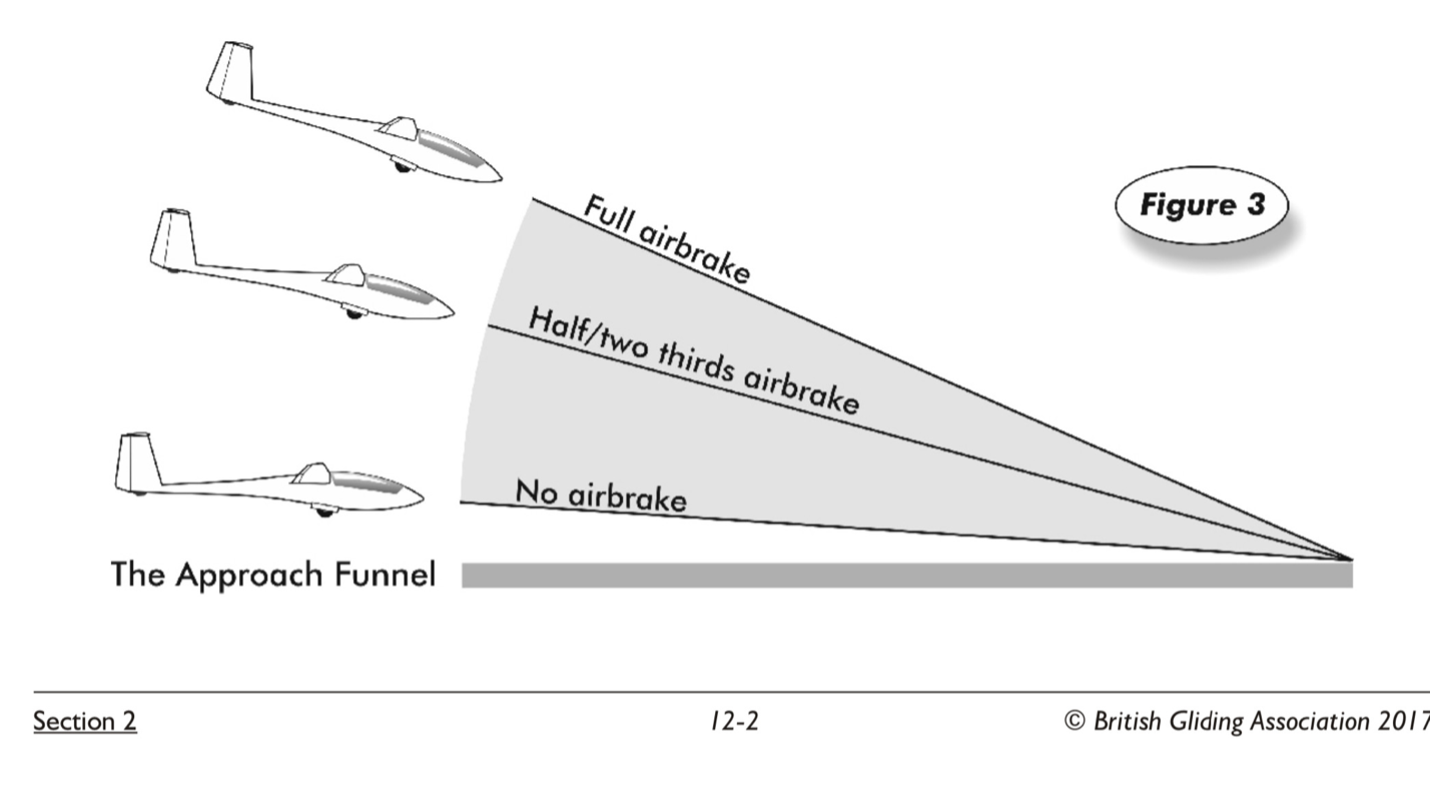Approach Wedge
Keep it normal
Let’s more fully describe the approach wedge. In order to have stabilized approach, the glider must turn onto final within the useful effectiveness of the glider’s dive brakes or spoilers. The ideal is to rollout and use 1/2 to 2/3 of the available dive brakes on final. See the diagram below.

Each type of glider is different in its glide performance and the effectiveness of the dive brakes and/or flap systems. The amount of headwind and, on rare occasions, tailwind will also affect the geometry of the approach wedge. At Harris Hill, anticipated sink, especially the dreaded waterfall effect, will alter the pilot’s assessment of the wedge as well. Therefore, it is not possible to put hard numbers in terms of feet or angles on the approach wedge. Sorry numbers people! As already stated, the goal is to be stabilized in the approach wedge from at least 200 ft AGL down to the landing zone.
Think about pilots flying single engine land airplanes. What does their approach wedge look like? They can use the engine to level the flight path completely. With a combination of landing flaps and a slip they can sink like a rock. If all else fails, they can go around. Glider pilots transitioning from powered flight should beware of the primacy of their initial flight experience.
Now think about a glider pilot who learned on a 4000 ft grass runway. Turning onto final high? Throw it into a slip and land a little bit further down the runway and they’re all set. Again, if this is the primacy of the flyer’s initial glider training, it may be a problem waiting to happen at Harris Hill. Adjustments on the base leg and turning final in the approach wedge are the solutions.
Judging the approach wedge is a major chunk of glider pilot proficiency. Both recency of experience and familiarity with the glider type come into play here. A keen pilot will know the correct sight picture for the glider flown, adjust this picture for different wind conditions, and can also observe the effectiveness of spoiler changes while still on base leg.
Judging the approach wedge at Harris Hill is further complicated by the terrain at either end. On north landings there is a knoll underneath the final. The visual sensation of this can tempt the pilot to stay too high avoiding being close to the trees. Landing south the 700 ft drop off has the reverse effect. Proper focus on the reference point is the remedy here. Again, we find this is an important and transferable concept in off-airport landings as the surrounding terrain will certainly look different.
1/2 to 2/3 spoiler extension is the ideal glide path. This allows for corrections for lift or sink. Active corrections to the spoiler handle are key to maintaining a steady descent to the landing zone. In order to continue a steady descent, the pilot must focus on the movement of the reference point in the pilot’s field of view. The pitch of the glider will change slightly as the pilot adjusts the spoilers. Use more dive brakes and the pilot must pitch down to maintain approach speed. Less dive brakes and the aircraft must pitch up somewhat. Therefore, a grease pencil mark on the canopy would not be a good sight for aiming at the reference point. Rather, everything that descends in the pilot’s eyeball will eventually be overflown and things rising as seen by the pilot will end up beyond the reference point. The pilot keeps flying the approach wedge in this manner until it is time for the round-out and flare. More on that later.

Notice not much has been mentioned about slips. The goal is turn final solidly within the useful range of the spoilers. This is especially true at Harris Hill. Slips will add some increased rate of descent to the approach but not much. This is even more true as we talk about slick high-performance gliders. Everyone needs to be proficient at slipping and should not hesitate to use the maneuver. But as a general rule, save the slips as a backup to excellent flight path planning.
Prioritizing a stable final approach is the key to every successful landing. Know and apply the concept of the approach wedge and know the specific capabilities of the glider flown.